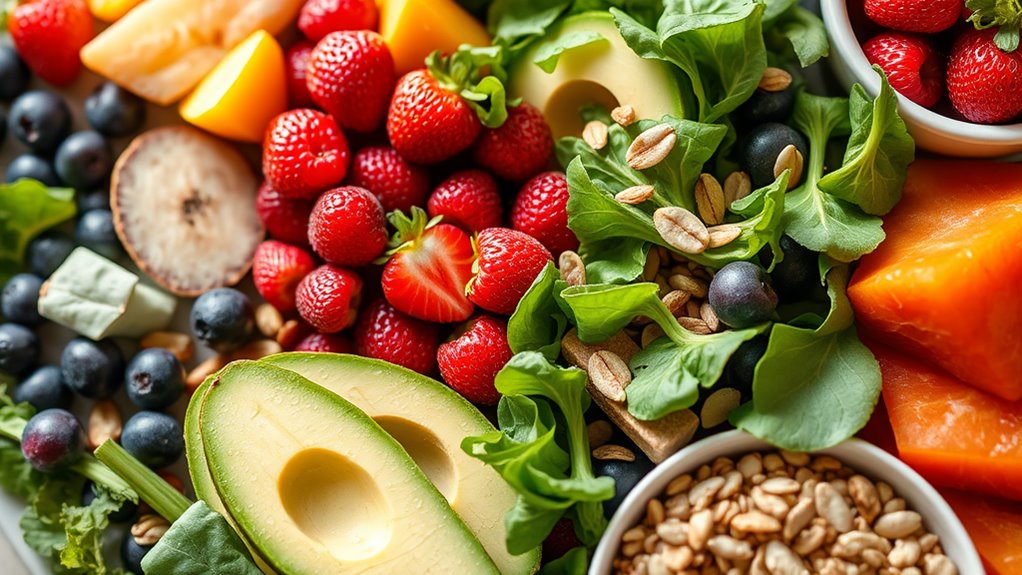Don’t Diet-Eat Smart With These Science-Backed Food Tips
You’ve probably heard countless diet fads promising quick results, but they often overlook what really matters: listening to your body. Understanding your hunger signals is crucial for making smarter food choices. Instead of restricting yourself, focus on nutrient-dense foods that fuel your body effectively. By prioritizing whole foods and incorporating more protein, you can enhance your satisfaction with meals. Curious about how to make these changes seamlessly? Let’s explore practical strategies to transform your eating habits.
Understand Your Hunger Signals
How well do you really understand your hunger signals? Recognizing these signals is crucial for smart eating.
Your body communicates hunger through physical cues like stomach growling or fatigue. However, emotional triggers can often confuse your signals, leading to overeating. To eat smart, pay attention to when you feel truly hungry versus when you’re bored or stressed. Try keeping a journal to track your hunger levels and food intake. This awareness helps you distinguish between genuine hunger and emotional cravings, enabling you to make more informed choices about when and what to eat, ultimately fostering a healthier relationship with food. Additionally, recognizing true physical hunger can empower you to respond appropriately to your body’s needs rather than emotional triggers.
Prioritize Whole Foods
Prioritizing whole foods can significantly boost your overall health by providing essential nutrients without added sugars and preservatives.
Simple swaps, like choosing brown rice over white or fresh fruits instead of juice, can make a big difference. Incorporating nutrient-dense foods into your diet can further enhance your wellness by ensuring you receive a variety of vitamins and minerals essential for optimal health.
Benefits of Whole Foods
Whole foods offer a wealth of benefits that can significantly enhance your overall health. They’re packed with essential nutrients, including vitamins, minerals, and antioxidants, which support your immune system and reduce the risk of chronic diseases.
Eating whole foods can improve digestion, thanks to their natural fiber content, which aids in gut health. Moreover, they tend to be lower in added sugars and unhealthy fats, helping you maintain a healthy weight.
Easy Whole Food Swaps
Making the switch to whole foods doesn’t have to be overwhelming.
Simple substitutions can make a big difference in your diet.
Here are some easy swaps to get you started:
-
Choose brown rice instead of white rice for added fiber.
-
Swap sugary cereals for oatmeal topped with fresh fruit.
-
Replace potato chips with air-popped popcorn for a crunchy snack.
-
Use Greek yogurt instead of sour cream for a protein boost.
These small changes enhance your meals’ nutritional value, helping you feel fuller and more energized.
Embrace these swaps, and you’ll be well on your way to eating smarter!
Incorporate More Protein
Incorporating more protein into your diet can significantly enhance your overall health and well-being.
Research shows that protein helps build muscle, supports weight management, and keeps you feeling full longer.
Aim for lean sources like chicken, fish, beans, and legumes.
Consider adding Greek yogurt or cottage cheese to your snacks for a protein boost.
If you’re plant-based, quinoa and edamame are excellent choices.
Try to include protein in every meal; for example, add eggs to your breakfast or nuts to your salads.
Additionally, studies indicate that eggs, despite their cholesterol content, can be part of a healthy diet when consumed in moderation, as they provide essential nutrients and high-quality protein.
Stay Hydrated
Staying hydrated is just as important as adding protein to your diet when it comes to maintaining optimal health.
Proper hydration supports digestion, energy levels, and overall well-being.
Here are some practical tips to keep your body hydrated:
-
Drink water before meals to help control appetite.
-
Carry a reusable water bottle to encourage regular sips throughout the day.
-
Infuse water with fruits or herbs for a flavorful boost.
-
Monitor your urine color; pale yellow indicates good hydration.
-
Remember that proper hydration can also enhance athletic performance and cognitive function.
Practice Mindful Eating
How often do you find yourself eating while distracted by screens or other activities?
Practicing mindful eating can transform your relationship with food.
Focus on your meal—notice the colors, textures, and flavors.
Chew slowly and savor each bite; research shows this enhances satisfaction and reduces overeating.
Put away distractions and create a calm atmosphere during meals.
Listen to your body’s hunger cues; eat when you’re hungry and stop when you’re full.
This awareness helps you make healthier choices and fosters a greater appreciation for your food. Incorporating mindful eating habits into your daily routine can lead to lasting changes in how you relate to food.
Plan Your Meals Ahead
Planning your meals ahead can make a significant difference in your eating habits and overall health.
When you take the time to organize your meals, you’re more likely to make healthier choices and avoid impulsive eating.
Taking the time to plan your meals leads to healthier choices and helps curb impulsive eating.
Here are some practical tips to get started:
-
Create a weekly menu to visualize your meals.
-
Make a shopping list based on your menu to avoid unhealthy items.
-
Prepare ingredients in advance to save time during the week.
-
Batch cook meals for easy access to nutritious options. Additionally, incorporating time-saving strategies can streamline your meal prep process and reduce stress throughout the week.
Build a Balanced Plate
Building a balanced plate is essential for fueling your body with the right nutrients. Aim to fill half your plate with fruits and vegetables, one-quarter with lean proteins, and one-quarter with whole grains. This combination not only supports your health but also boosts energy levels. Incorporating simple tricks can make it easier to create meals that are both nutritious and satisfying.
| Food Group | Examples |
|——————|————————-|
| Fruits & Veggies | Spinach, Berries, Carrots|
| Lean Proteins | Chicken, Tofu, Beans |
| Whole Grains | Brown Rice, Quinoa |
| Healthy Fats | Avocado, Olive Oil |
Utilizing this structure helps you maintain a nutrient-rich diet effortlessly.




